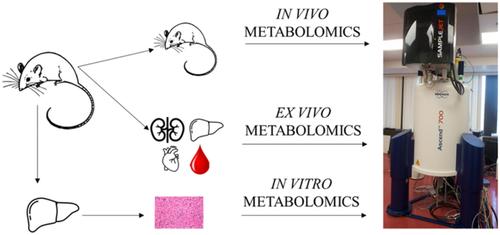当前位置:
X-MOL 学术
›
NMR Biomed.
›
论文详情
Our official English website, www.x-mol.net, welcomes your
feedback! (Note: you will need to create a separate account there.)
Closing the gap between in vivo and in vitro omics: using QA/QC to strengthen ex vivo NMR metabolomics
NMR in Biomedicine ( IF 2.7 ) Pub Date : 2021-08-08 , DOI: 10.1002/nbm.4594 Amith Sadananda Maroli 1, 2 , Robert Powers 1, 2
NMR in Biomedicine ( IF 2.7 ) Pub Date : 2021-08-08 , DOI: 10.1002/nbm.4594 Amith Sadananda Maroli 1, 2 , Robert Powers 1, 2
Affiliation

|
Metabolomics aims to achieve a global quantitation of the pool of metabolites within a biological system. Importantly, metabolite concentrations serve as a sensitive marker of both genomic and phenotypic changes in response to both internal and external stimuli. NMR spectroscopy greatly aids in the understanding of both in vitro and in vivo physiological systems and in the identification of diagnostic and therapeutic biomarkers. Accordingly, NMR is widely utilized in metabolomics and fluxomics studies due to its limited requirements for sample preparation and chromatography, its non-destructive and quantitative nature, its utility in the structural elucidation of unknown compounds, and, importantly, its versatility in the analysis of in vitro, in vivo, and ex vivo samples. This review provides an overview of the strengths and limitations of in vitro and in vivo experiments for translational research and discusses how ex vivo studies may overcome these weaknesses to facilitate the extrapolation of in vitro insights to an in vivo system. The application of NMR-based metabolomics to ex vivo samples, tissues, and biofluids can provide essential information that is close to a living system (in vivo) with sensitivity and resolution comparable to those of in vitro studies. The success of this extrapolation process is critically dependent on high-quality and reproducible data. Thus, the incorporation of robust quality assurance and quality control checks into the experimental design and execution of NMR-based metabolomics experiments will ensure the successful extrapolation of ex vivo studies to benefit translational medicine.
中文翻译:

缩小体内组学和体外组学之间的差距:使用 QA/QC 加强离体 NMR 代谢组学
代谢组学旨在实现生物系统内代谢物池的全局定量。重要的是,代谢物浓度可作为响应内部和外部刺激的基因组和表型变化的敏感标记。NMR 波谱极大地有助于理解体外和体内生理系统以及诊断和治疗生物标志物的鉴定。因此,NMR 广泛用于代谢组学和通量组学研究,因为它对样品制备和色谱法的要求有限,具有非破坏性和定量性,可用于未知化合物的结构解析,而且重要的是,它在分析化合物方面的多功能性体外、体内和离体样品。本综述概述了用于转化研究的体外和体内实验的优势和局限性,并讨论了离体研究如何克服这些弱点以促进将体外洞察力外推到体内系统。将基于 NMR 的代谢组学应用于离体样品、组织和生物流体,可以提供接近活体系统(体内)的基本信息,其灵敏度和分辨率可与体外研究相媲美。这种外推过程的成功关键取决于高质量和可重现的数据。因此,
更新日期:2021-08-08
中文翻译:

缩小体内组学和体外组学之间的差距:使用 QA/QC 加强离体 NMR 代谢组学
代谢组学旨在实现生物系统内代谢物池的全局定量。重要的是,代谢物浓度可作为响应内部和外部刺激的基因组和表型变化的敏感标记。NMR 波谱极大地有助于理解体外和体内生理系统以及诊断和治疗生物标志物的鉴定。因此,NMR 广泛用于代谢组学和通量组学研究,因为它对样品制备和色谱法的要求有限,具有非破坏性和定量性,可用于未知化合物的结构解析,而且重要的是,它在分析化合物方面的多功能性体外、体内和离体样品。本综述概述了用于转化研究的体外和体内实验的优势和局限性,并讨论了离体研究如何克服这些弱点以促进将体外洞察力外推到体内系统。将基于 NMR 的代谢组学应用于离体样品、组织和生物流体,可以提供接近活体系统(体内)的基本信息,其灵敏度和分辨率可与体外研究相媲美。这种外推过程的成功关键取决于高质量和可重现的数据。因此,









































 京公网安备 11010802027423号
京公网安备 11010802027423号